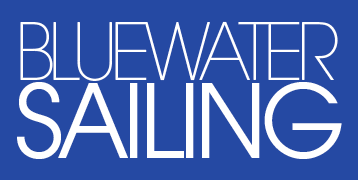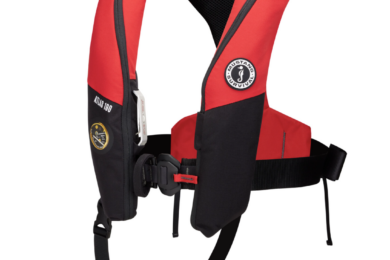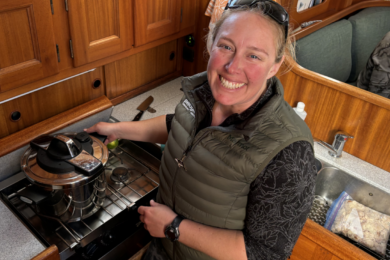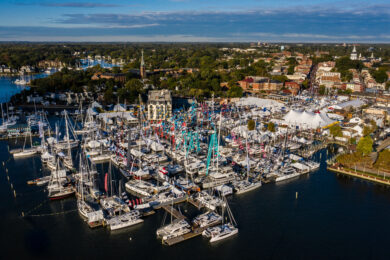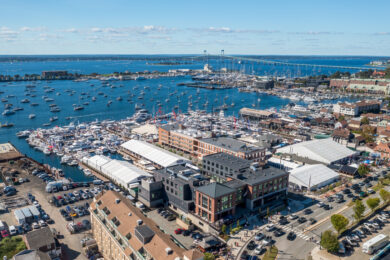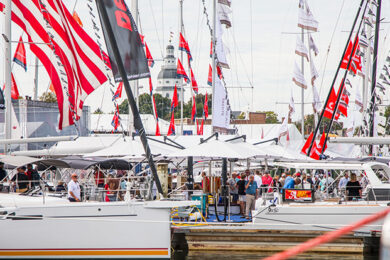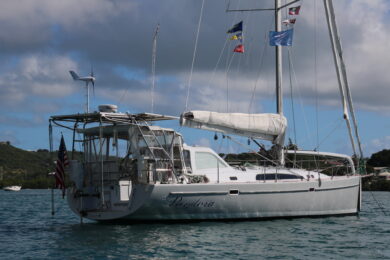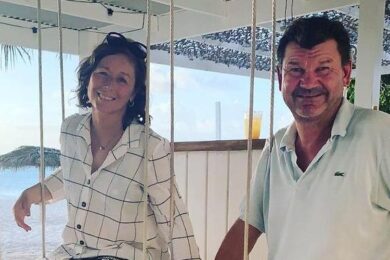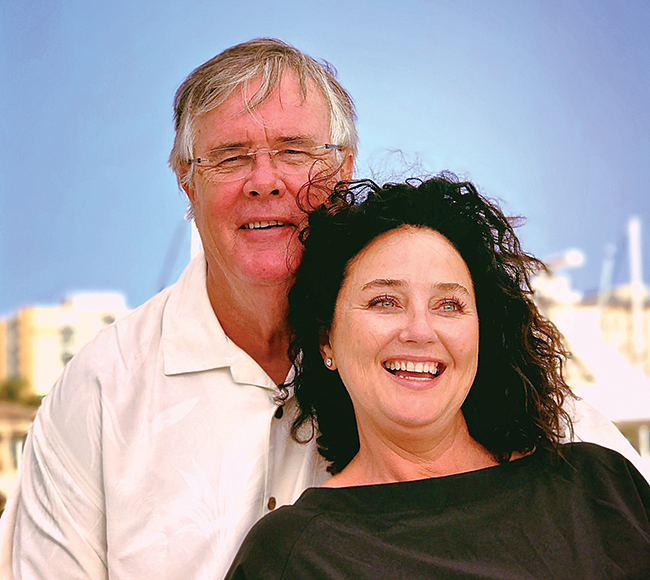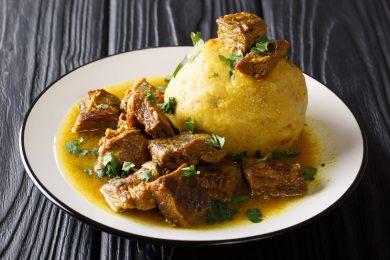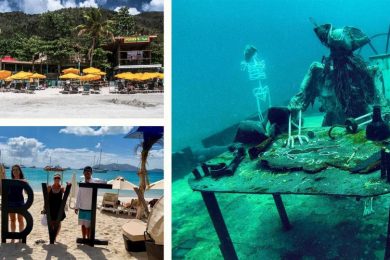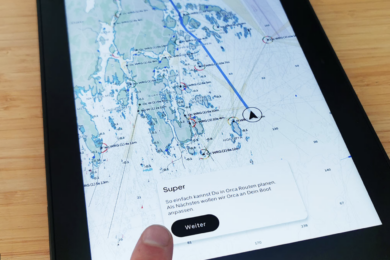 BAVARIA RISING • Our story and the story of the re-launch of Bavaria Yachts is an American one. But from my perspective, it has its beginnings in the coastal resort of Alacati on Turkey’s west coast, not far from the resort city of Cesme, a rugged, barren coastline that offers some of the best sailing and most interesting harbors in the Eastern Med.
BAVARIA RISING • Our story and the story of the re-launch of Bavaria Yachts is an American one. But from my perspective, it has its beginnings in the coastal resort of Alacati on Turkey’s west coast, not far from the resort city of Cesme, a rugged, barren coastline that offers some of the best sailing and most interesting harbors in the Eastern Med.
After an overnight flight to Turkey and a good night’s sleep, I set off from the Alacati Marina aboard the brand new Bavaria 50 on a crystal clear morning for a day of sailing trials. Around us, the brown hills rose above a rocky and often chalk-white coastline. In the distance, hilltop wind turbines spun slowly, hinting of better breezes as the day wore on. Onboard was Daniel Kohl, product manager of sailboats for Bavaria, and sailing consultant Pete Meyer, who works closely with Kohl. Both are Olympic-quality sailors, so the day promised to offer a clear look at just how well the 50 performs despite the light breeze.
The 50 is a sister ship to the Bavaria 45, 40, 36 and 32, all of which were designed by Farr Yacht Design and styled by BMW Designworks USA. The Bavaria 55, which I have not yet had a chance to test, is the fleet’s flagship but has some noticeable design differences.
Up until recently, Bavarias were designed by the Slovenian J&J Yacht Design Group. The boats were traditional, 1990s-style moderate displacement cruising sloops that had proven very popular but had become dated. When Bavaria’s new corporate owners decided to completely redesign the product line, they aimed at improving the boats’ sailing performance and opening up and brightening the interiors.
The choice to partner with Farr ensured that the new line of cruisers would be fast, easy to sail and weatherly. On that lovely Med day in early June, we got a chance to put the new 50 through its paces and to have a thorough look at how the design and construction of the boat fulfills its purposes.
 The Bavaria Cruiser design comes standard with in-mast roller furling mainsails and roller furling jibs. The 50 we were testing had a custom set of laminated sails that were handsome and purposeful as we rolled them out to meet the moderate but building westerly breeze. The mainsail had full height vertical battens with fractional battens between them to give the sail a nice roach and to keep the laminate flat and aerodynamic. The jib was cut to 108 percent of the foretriangle, so it could sheet inside the outboard shrouds and chainplates. This headsail arrangement makes the foresail easy to handle during tacks and jibes, while the close sheeting angle enables the boat to sail very close to the wind.
The Bavaria Cruiser design comes standard with in-mast roller furling mainsails and roller furling jibs. The 50 we were testing had a custom set of laminated sails that were handsome and purposeful as we rolled them out to meet the moderate but building westerly breeze. The mainsail had full height vertical battens with fractional battens between them to give the sail a nice roach and to keep the laminate flat and aerodynamic. The jib was cut to 108 percent of the foretriangle, so it could sheet inside the outboard shrouds and chainplates. This headsail arrangement makes the foresail easy to handle during tacks and jibes, while the close sheeting angle enables the boat to sail very close to the wind.
An interesting solution to mainsail trim, given the in-mast furling sail, is the way Bavaria has set up the main sheet. Leach tension and draft are always issues with in-mast furling sails since they have no battens on the leach and because the sail has to be cut flat to roll up neatly. Usually, such rigs have both a boom vang and a traveler to control sail shape. The vang trims the leach, while the traveler adds or subtracts power from the sail. Bavaria has eliminated the traveler, which many cruisers never use, replacing it with a dual mainsheet, mid-boom sheeting system. This setup allows you to adjust the angle of the sail relative to the wind in minute increments, acting just like a traveler, but simpler to use.
As we tacked out the channel and into the Med, we got a good feel for how the 50’s rig works with the hull design. The boat was a cinch to tack and trim. In the moderate breeze, we found that we had plenty of sail area upwind and that the 50 would carry her way through tacks nicely. The narrow sheeting angles allowed us to tack inside 80 degrees to the true wind—very close indeed for a full volume cruising boat with a roller furling rig.
Both the 50 and her smaller 45-foot sistership have twin rudders under the extra wide transom. These prevent the boat from stalling when heeled over and give the helmsman the feel of a boat running on rails. The 50 steers beautifully and surely, and you can find the “groove” upwind with fingertip control.
Off the wind, we hoisted the big reacher, which was stowed in a full-hoist spinnaker sock similar to an ATN snuffer but built by Elvstrom. The sail tacked down to the anchor rollers on the bow and sheeted through snatch blocks near the quarters. With the big sail drawing, the 50 leaped ahead nicely. Sailing at 140 degrees to the true wind, we achieved near hull speed of 9 knots in the modest 10 to 12 knots of wind. The 50 is a slippery design that will make enthusiastic sailors happy with its upwind and off the wind performance. And with the reacher really drawing in the puffs off the hills, the twin rudders kept the boat completely under control; even the autopilot had no problem steering through puffs.
On our way back to the marina, we rolled in the sails in order to put the boat through her paces under power. The 50 had the optional 72-horsepower Volvo diesel and a three-bladed Gori folding prop on the saildrive, so it was optimally set up for powering. With the prop in normal mode, the engine maxed out at 3400 rpms and drove the 50 at 9 knots in flat water. From full speed to full stop, with the engine hard in reverse, the 50 needed only three boat lengths. In reverse, there was no prop walk to speak of. And, with the Gori in “overdrive” mode, a unique function of these propellers, the engine maxed out at 2200 rpms and still achieved hull speed. The only hiccup with a single prop, twin rudder design is the lack of prop wash on the rudders at slow speeds around the docks to give you steerage; the 50 has to be moving for the rudders to bite the water effectively.
The 50 was a lot of fun to sail and easy for two people to handle upwind with the plain working sails and off the wind with the reacher flying. It was close-winded, fast on all points of sail and sailed best when trimmed for minimum heeling angles, which will please most crew. Under power, the boat handled surely underway and around the marina docks; with the lack of prop walk and the bow thruster, it was simple to moor despite its length and ample beam. The 50 is a great sailing family cruiser, but it can certainly be handled effectively by a couple on their own who will appreciate the rig’s simplicity and performance.
LIVING ABOARD
The Bavaria 50, like her sisterships, can be built with a fairly wide array of owner-specified arrangements and interior details. Because the boats are built to order in a high volume production facility in Bavaria, Germany, you can select the interior veneers, fabrics and cabin configurations to suite your tastes and needs. And you can add to the boat’s equipment from a long list of options. Boats that will be imported to North America by the new Bavaria distributor will have a lot of “options” spec’d out as standard equipment, so buyers can truly take possession of their new boats in cruise-away condition. Interestingly, if you order a Bavaria today, your brand new, semicustom boat can be in your slip and ready to cruise in about eight weeks.
The 50 we sailed was fairly tricked out with options. It had the three-cabin, three-head layout, which will be preferred by families who won’t be chartering the boat or sailing with masses of relatives. Four- and five-cabin versions are also available. Because of the 50’s 15 feet of beam and generous hull volume, it is possible to have side-by-side double cabins forward, quarter cabins aft and a pullman cabin with bunk berths tucked in forward.
The 50’s saloon has the chart table and galley to port and the huge dinette to starboard. With seven deck hatches, opening ports, sealed hull portlights and a light-colored vinyl overhead, the interior is full of light and well-ventilated. Each of the cabins and heads had opening deck hatches and cross-ventilation with opening ports.
The galley to port has a unique layout for a side-galley design since it is U-shaped and offers a sea cook plenty of places to brace a hip or knee while working with both hands in bumpy conditions. A stainless steel rail runs along the whole galley, so you always have a secure handhold and a place to fasten a galley belt.
The dinette will seat six comfortably and can accommodate eight in a pinch. There is a lot of storage under and behind the bench seats. This is where the family will gather for most evening meals and in cool or rainy weather; it is just like sitting around the kitchen table at home. In warmer conditions, the cockpit will be the center of family life since it is large enough to fit a crowd, and the centerline table will seat the whole family for al fresco meals. With a dodger and bimini fitted, the cockpit will be almost like a covered porch or patio.
One of the signature design features of the new Bavaria line is the wide, fold-down transom that converts from the back bulkhead of the cockpit into a nearly full-beam swim platform. On the 55, 50 and 45, the platform is raised and lowered with a small motor; on the smaller boats, you operate it by hand. The platform on the 50 is wide enough for four people to sit abreast and has a mountable ladder with four teak-clad steps that makes it simple to climb out of the water. With the stern platform raised, the cockpit is completely enclosed and secure; with the platform down, the aft quarter of the boat becomes a huge outdoor living area.
With lots of interior volume and headroom, a commodious saloon, large sleeping cabins and heads with showers, and the spacious cockpit and swim platform on deck, the new Bavaria 50 offers her owners a truly spacious and comfortable floating home.
CONSTRUCTION AND DETAILS
The Bavaria factory in Germany has become famous as one of the most modern and largest production facilities in the world, capable of turning out as many as 3,000 boats a year if the demand is there. But that doesn’t mean all of the boats come out of identical cookie cutters.
Instead, Bavaria allows you to choose the color and type of fabric you want, the interior veneers—mahogany, oak or walnut—and the type of floor laminates that will match your fabric and veneers. In all but the 32, you can opt for several different layouts. There is an extensive array of options to choose from, including engine size, prop, sail quality, cockpit canvas and cushions.
As noted above, the boats coming to the U.S. will have a baseline specification list that includes Garmin navigation and wind instruments and an autopilot. While you can make a lot of decisions about the boat before it is built, the basic construction and engineering that goes into each boat remains the same. The hulls are hand-laid fiberglass with Coremat coring below the waterline and Airex coring above the waterline and in the deck; Coremat adds bulk and panel strength, while Airex adds panel strength and a high level of noise and heat insulation.
Leaping around on deck while setting the reacher and handling docking lines, we were impressed by the boat’s stiffness underfoot. And, with the engine revving high and the prop churning on the saildrive, the noise level in the cockpit was insignificant. The hull is laminated with anti-osmotic isophthalic resins to prevent water penetration and hull blisters.
Boats imported to the U.S. and Caribbean will have an additional barrier coat of Interlux’s epoxy Interprotect 2000E. The hull-to-deck joint is glued with a space-age adhesive, then tapped and screwed together with the toe rail at eight-inch intervals. The keel-to-hull joint is extremely robust with large steel backing plates for each bolt that are then glassed into the hull.
Both the deck and hull have been stiffened with top-hat style grid sections that spread the loads of the rig and keel to the whole boat, thus eliminating any twist or movement as the boat moves through waves or reacts to strong winds. With the mast’s shrouds moved outboard to accommodate the small headsail and inboard sheeting, the chainplates become an integral part of the hull and deck construction. The chainplates are tabbed into gussets inside the hull that are in turn tabbed into the internal hull grid; the net result is a structure that can’t move even under the greatest loads.
As we poked around the interior of the new 50, we were impressed with the thought that has gone into the layout of systems, seacocks, plumbing, wiring and the installation of optional equipment, whether that be air conditioning or a genset. Access to engineering is as good as you will find on any boat, so general engine and genset maintenance and system troubleshooting will not require a contortionist.
The new Bavarias have definitely been designed and engineered by sailors who know the difference between what works and what doesn’t aboard a well used cruising boat.
THE FLEET
The week following my trip to Turkey, I had the chance to visit with the new principals at Bavaria Yachts USA in Annapolis, MD. I was fortunate to test-sail the four smaller boats in the new Cruiser line, which recently arrived in America. The new company is owned and run by Andrew Thompson and Sylvia Driver, who are the Caribbean Bavaria dealers and owners of Horizon Yacht Charters, and by their partner Kenny Feld, a serial entrepreneur and keen sailor. The Annapolis operation is run on a day to day basis by Jeff McCord, who has more than 30 years in the sailing industry, many of those with Beneteau USA as a senior sales executive. The depth of experience this management team brings to Bavaria USA is impressive.
The four boats we sailed in Annapolis—the 45, 40, 36 and 32—are variations on the themes we noted in detail in the 50 that we sailed in Turkey. The design characteristics, build quality and owner input into everything from fabrics to engine size remain the same. Yet, each is unique in its own way and will suit quite different needs and pocketbooks.
 BAVARIA CRUISER 45
BAVARIA CRUISER 45
Although five feet shorter than the 50, the 45 offers a lot of the same details. The cockpit has twin wheels for good visibility forward and access aft to the wide stern platform, which is electrically operated. The 45 has twin rudders and a shoal draft cast-iron winged keel. A bow thruster is standard in the U.S. The rig is very similar to the 50’s, with an in-mast roller furling mainsail, 108 percent jib and outboard chainplates. A conventional slab-reefing mainsail is available as an option, as are laminated sails and a reacher in a snuffer. Below decks, the 45 can be arranged with a three-cabin, three-head plan or a four-cabin, three-head layout. The saloon is similar to the 50 with the galley to port and the dinette to starboard. The chart table on the 45 faces aft and has a nifty folding seatback that is part of the dinette. Under sail, the 45 handled much the same as the 50. With twin rudders and a roller furling rig, the boat was easy to tack and jibe and managed to sail just as close to the wind. The boat is incredibly solid underfoot and gives the impression of a larger vessel. We noted during a change of crew on the fly that one of our larger sailors did not cause the 45 to heel at all as he climbed aboard from the chase boat. As very close sister to the 50, the 45 will appeal to those who want a big cruising boat with a lot of volume but do no need the size and extra volume the 50 provides.
 BAVARIA CRUISER 40
BAVARIA CRUISER 40
Of the four boats tested in Annapolis, the 40 was the first I sailed. I had the good luck to be out on the Chesapeake Bay in the late afternoon when the breeze was blowing nicely and the afternoon sun not too intense. With just Andrew Thompson and me aboard, we close reached out of Annapolis harbor and then started short tacking southeast into the breeze. Andrew is a crack sailor in the Caribbean and handled sail trim as I helmed the boat through her tacks. To my delight, we found that the 40 was capable of saiing 8 plus knots when well trimmed in a moderate breeze of 10 to 12 knots, easily tacking inside 75 degrees of true wind. Modern racing boats do this or even better, but it is a rare cruising boat, with all that furniture down below, that so nimbly gets out of its own way. The 40 has only one layout option—three double cabins with two heads—which makes it great for a couple who enjoy sailing with their friends. The galley lies along the port side, and the dinette to starboard will seat six. There is a good size chart table aft of the dinette. The 40 is a lot of fun to sail, close winded and very well laid out for cruising.
 BAVARIA CRUISER 36
BAVARIA CRUISER 36
After sailing the 45 and 40, we expected the 36 to feel like a much smaller boat when we stepped aboard. But that was not the case at all. The 36 feels big underfoot, big when puffs fill the sail, and big when you go below to the cabins. There are two interior plans for the 36—a two-cabin, one-head layout and a three-cabin, one-head configuration. Big quarter cabins are rare in 36 footers, but aboard the Bavaria, with all of the volume and beam, the two cabins aft work well. Although the boat has only one head—plenty for a 36-footer—the compartment is large and has a glass partition to make it into a shower, too. Under sail, the 36 surprised us again by being extremely quick. We crossed tacks up the Severn River with the 45 and found that in the light airs, we were able to point a little higher and sail just about as fast. More breeze would have tipped the scale in the 45’s favor, but in the light stuff, we did very well. A great couple’s cruiser, the 36 will really appeal to those who want to sail wherever they go and want the ability to go to windward handily. Also, the 36 offers more interior volume than many 38- or 40-footers.
 BAVARIA CRUISER 32
BAVARIA CRUISER 32
The 32 was the last boat we sailed over the two days we spent in Annapolis, and in many ways it was like saving the best for last. Not that the 32 surpasses her bigger sisters in any particular way; it was simply obvious that here was a little boat with a big heart and a lot of room for a young family or an older couple looking to simplify their cruising life. First and foremost, the 32 sailed like a dream and was as weatherly as the bigger boats. With the small headsail, the 32 is easy to singlehand and will be fun for those who like to sail to and from their moorings. The Farr Yacht Design pedigree really shines through in this boat. We were equally impressed with the 32’s two-cabin, one-head layout, which offers a double cabin aft under the cockpit and a smaller guest or kid’s cabin forward. The benches in the saloon can double as berths, too. The galley is aft at the foot of the companionway ladder with the aft-facing chart table across from it. The L-shaped dinette will seat four for dinner. A perfect weekender with the capability of carrying you off for weeks of vacation at a time, the Bavaria Cruiser 32 will make a perfect starter boat or an equally fine last cruiser for those who have seen it all.
